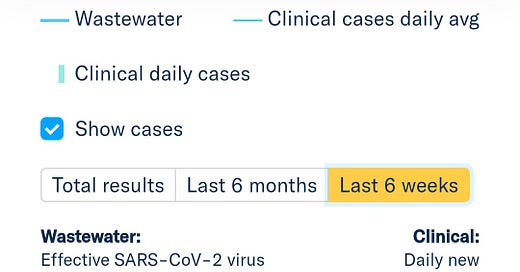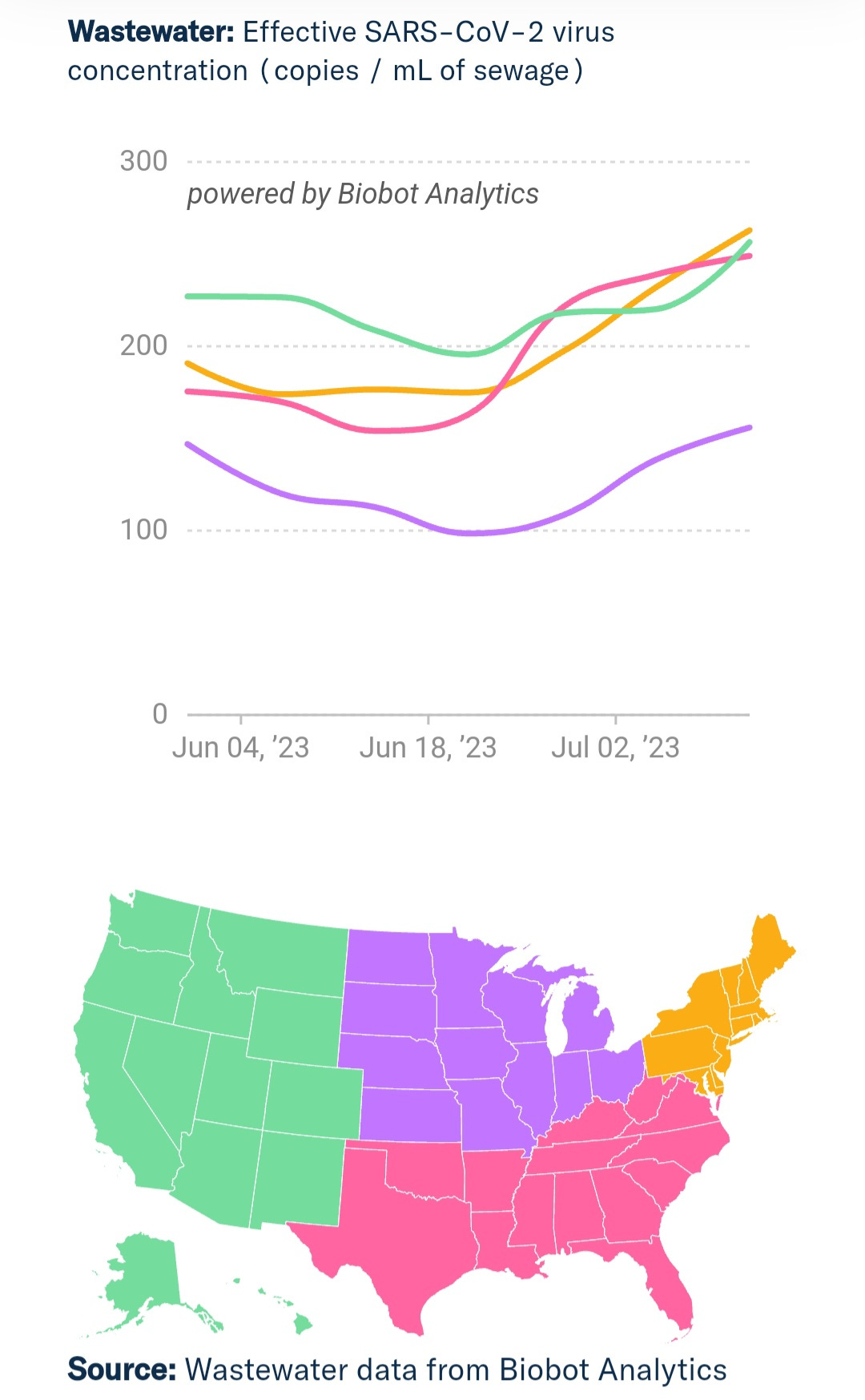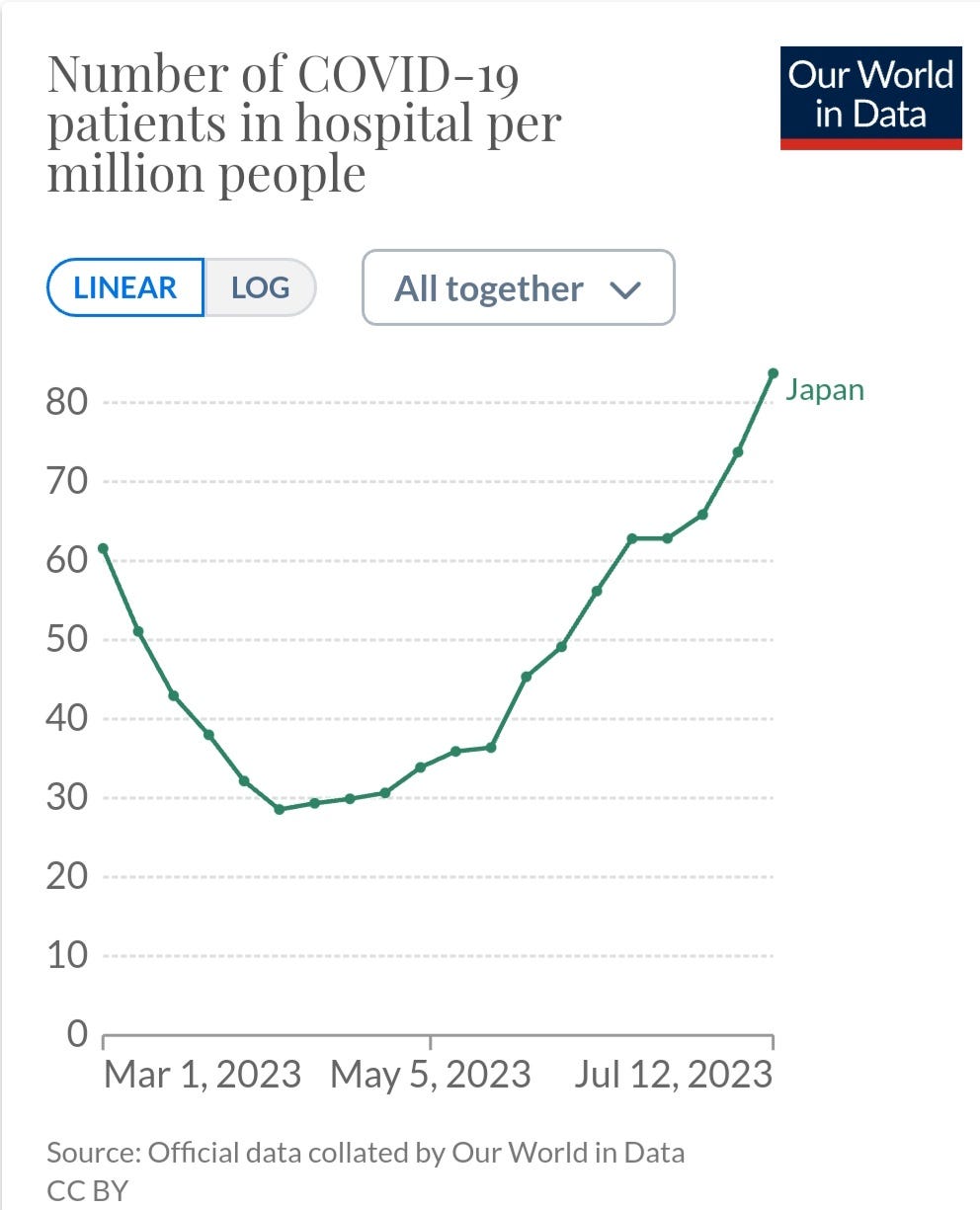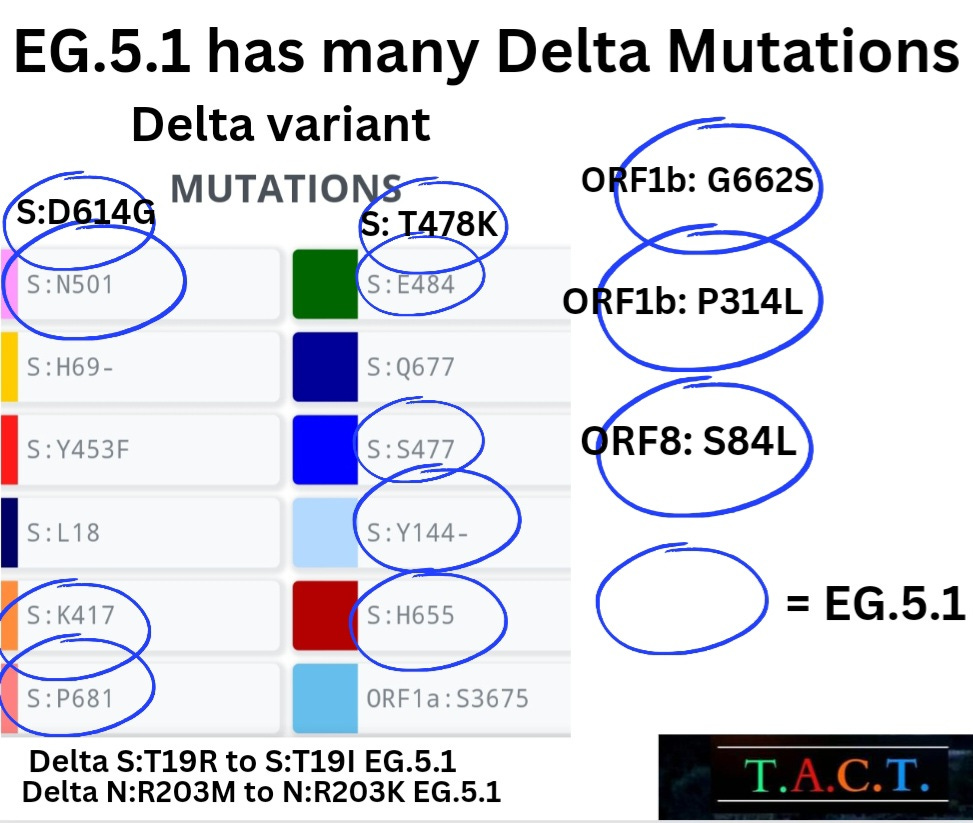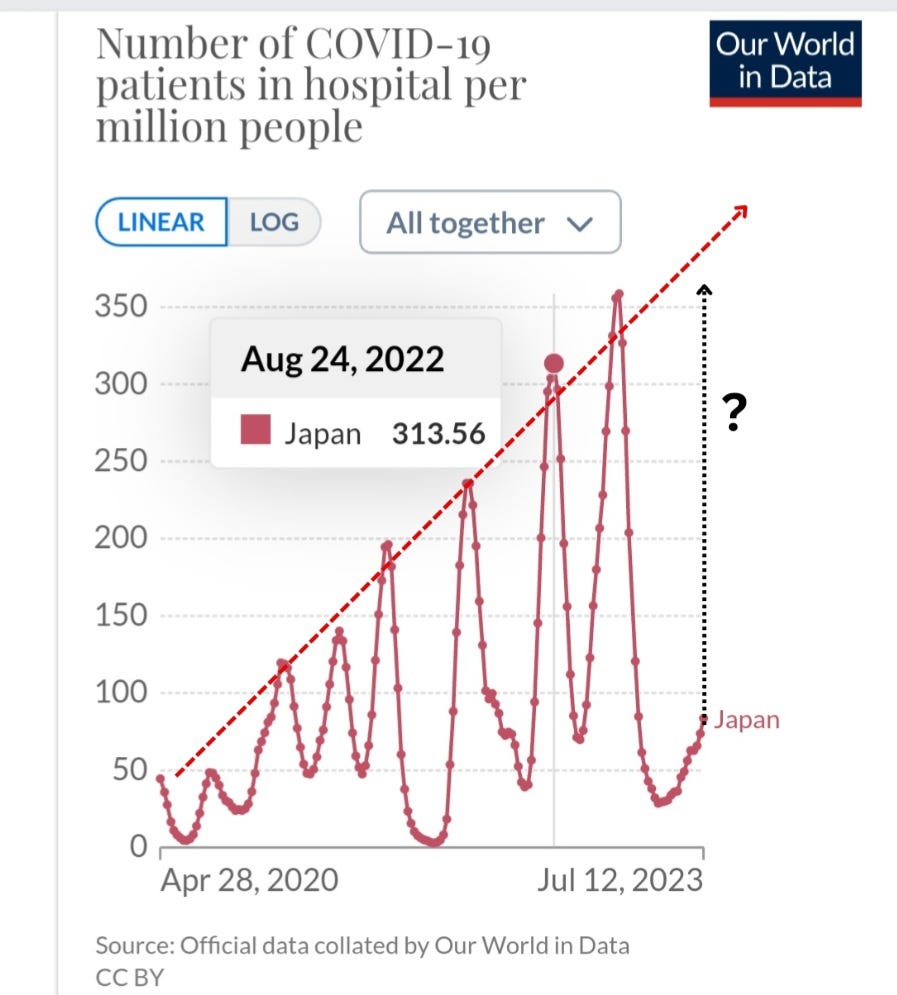COVID Update July 19, 2023-Unveiling a Potential Threat: Does a Novel Variant Mimic Delta's Effects, Contributing to Rising Hospitalizations in Japan? A new surge underway in the U.S.
Wastewater Data Unveils Concerning Trend: COVID Cases Increasing in the U.S., Some Areas Experiencing Sharp Rises
COVID is on a steady climb in the U.S. according to the wastewater data. Many areas are seeing more dramatic increases.
When examining the data regionally, it becomes evident that all areas are experiencing growth in COVID cases at a similar pace.
According to the CDC variant proportions, the EG.5 variant has the greatest potential to become the the dominant variant.
Recent reports have raised concern as people experience a loss of smell and taste following infections, similar to the Delta variant's impact. The question now arises: Could a new variant be mirroring Delta's behavior? Could it be contributing to Japan's rising hospitalizations?
Let’s explore these questions and dig deeper. Paid Subscribers Get Early Access, Full Release for our Free Subscribers Just Around the Corner.
When investigating the potential cause of reported loss of smell and taste, it has been observed that EG.5.1 shares many of the same mutations with the Delta variant. As we know, the Delta variant was previously associated with a significant number of cases involving loss of smell and taste. Considering these similarities, it is plausible that EG.5.1 might also be efficient at breaking down the mucosal barrier in the nose.
If this variant indeed behaves similarly to Delta, there could be a higher likelihood of more people becoming infected, experiencing a loss of smell, and a diminished sense of taste. Additionally, there may be an increased risk of COVID-19 affecting the brain, although this is still a hypothesis and requires further investigation.
One crucial aspect to note is that EG.5.1 possesses many more mutations than Delta, which complicates the understanding of its potential impact and how the situation might unfold. As COVID-19 continues to evolve, it demonstrates a clear ability to evade prior immunity and counteract our immune system's defenses.
Given the complexity of this scenario, ongoing research and scientific contributions are vital. Anyone with relevant information or insights is encouraged to leave comments and contribute to our understanding of this evolving situation. As we witness COVID-19's ongoing adaptations, staying informed and being prepared to respond effectively to emerging variants is crucial for safeguarding public health.
EG.5.1 has been sequenced in 35 countries and at least 30 U.S. states. Due to the lack of sequencing it is likely going unreported in a vast number of places.
Let's take a look back at Japan.
In the past 3 years, Japan hospitalizations peeked each summer between Aug 15 and the 24th. We shall see how high they go between now and then but the potential is there for even more people to end up hospitalized than the prior years.
Why does it peek at the same time every summer? Schools end for the summer around July 20th and hospitalizations tend to keep increasing for a few weeks after the primary driver of exponential growth is closed. The transmission between classrooms and homes continues to be the primary force behind the exponential growth of these variants. When the protections are removed the baseline remains higher so transmission continues.
On May 8th, Japan downgraded COVID from level 5 to level 2 which makes it on par with the seasonal flu from their public health response stand point.
In Japan, both EG.5.1 and EG.5.1.1 variants are showing an upward trend in prevalence, indicating the possibility that these variants might be associated with more severe symptoms. However, it remains uncertain if any countries or institutions are actively studying these variants to gain a deeper understanding of their characteristics.
The major concern lies in the world's readiness to respond swiftly in case these variants indeed prove to be more severe. Unfortunately, the current state of genomic surveillance is not in alignment with the recommendations made by the World Health Organization (WHO), which emphasized the necessity of increasing surveillance efforts.
Regrettably, most countries have opted to decrease their genomic surveillance, which poses a potential risk. There could be other variants that have yet to be identified, and even those we are aware of might be significantly underreported.
To safeguard global public health, it is crucial that countries and institutions collaborate and reinforce genomic surveillance efforts. By doing so, we can better monitor the spread and impact of variants, enabling us to respond promptly and effectively to contain potential outbreaks. Enhancing surveillance will be instrumental in our ability to tackle emerging variants and ensure a more prepared response to any potential threats they may pose.
Currently, in the United States, the presence of certain variants in wastewater is on the rise in numerous areas, even though the overall prevalence remains relatively low compared to previous levels observed in most parts of the country.
It is crucial to be aware that the variants circulating now are among the most immune evasive and suppressive strains to date. Therefore, it is of utmost importance to exercise caution and take necessary precautions while going out and about during the summer months.
Based on current projections, the prevalence is expected to continue increasing until mid-August in the U.S., after which it should start declining again throughout September.
Looking ahead to the Fall and Winter seasons, we anticipate witnessing an exponential growth of COVID, RSV, Flu, and other viruses. This growth is expected to be facilitated by the movement of individuals between schools and homes, especially in institutions that have not upgraded their air filtration and ventilation systems. This pattern of transmission may expose millions of people to these infectious agents, resulting in numerous lost days of school and work, and unfortunately, causing severe illness and fatalities.
The good news is that this situation is both predictable and preventable. By implementing appropriate measures and making necessary upgrades to schools' air filtration and ventilation systems, we can significantly reduce the risk of widespread transmission and its dire consequences. Let us all remain vigilant and work together to safeguard our communities and loved ones.
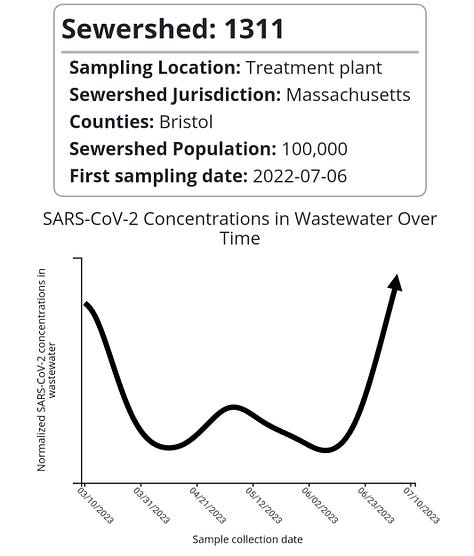
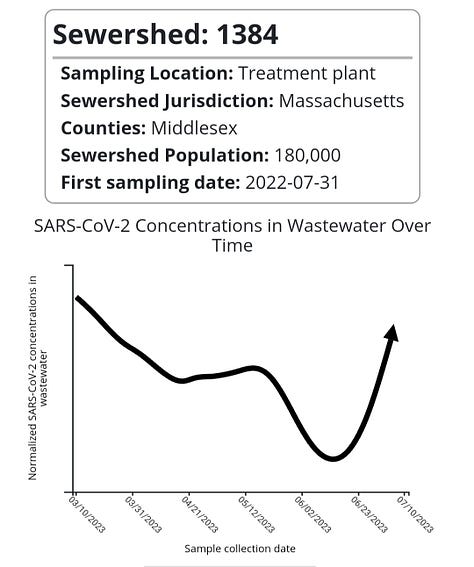
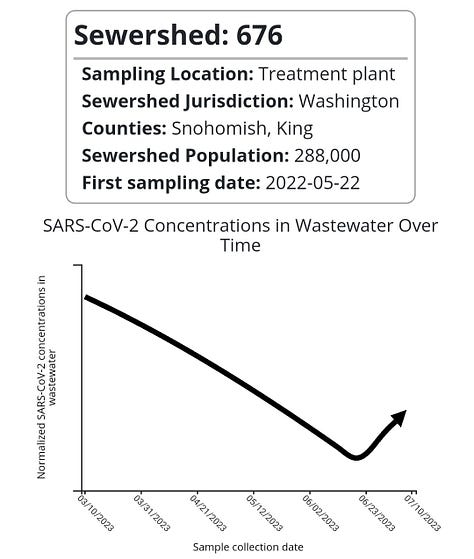
Is anyone within the major media outlets or government disseminating this critical information to the public? Regrettably, the answer appears to be No. Both the government and media seem to have adopted a "COVID is over" strategy, neglecting to acknowledge the long-term ramifications this disease continues to inflict on individuals and the alarming surge in disabling conditions. The data unveils an unsettling reality: an estimated 38,390,183 adults in the United States are currently wrestling with Long COVID symptoms, extending well beyond the three-month threshold. The gravity of this situation demands attention and awareness to better support those affected by the enduring impact of COVID-19.
Insights on Long COVID, the Economic Impact to Households, and how Reinfections are Increasing Risks.
Here we look at some more insights from the ongoing U.S. Census Bureau survey. They have been collecting data on a range of ways in which people’s lives have been impacted by the pandemic. The Household Pulse Survey shows that over the different weeks of the survey, sorting the states by the lowest percentage to the highest percentage of people reportin…
Let us know what you're seeing or experiencing where you are or any other insights you may have.


